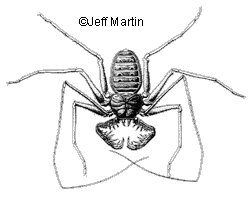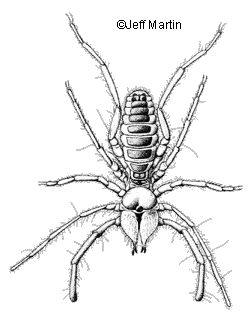Tailless Whipscorpions & Sun Spiders
Tailless whipscorpions look at first glance like spiders. The first appendages (pedipalps) are modified for grasping prey, with hook-like projections. The first true pair of legs is modified to serve as “feelers,” and are long, delicate, and whip-like, with many fine hairs.
Distribution
Amblypygids are found in tropical regions throughout the world. In Arizona, these animals live in abandoned rodent burrows and along dry river washes in the Arizona Upland foothills.
| Order: Amblypygi |
| Family: Tarantulidae |
| Sonoran Desert Genera: tailless whipscorpion (Paraphrynus spp.) |
| Other common names: amblypygid, whipspider |
Order: Solifugae |
| Family: Eremobatidae |
| Sonoran Desert Genera: sun spider (Eremobates spp.) |
| Other common names: solpugid, windscorpion |
| Spanish name: matavenados |
 |
Ecology
Tailless whipscorpions are reclusive predators of insects. They hunt nocturnally, using their long, delicate first pair of legs to find their food. The spined pedipalps impale and crush the prey and then transfer it to the chelicerae (jaws). Tailless whip-scorpions can only pinch their prey; they lack venom glands.
Life History
After stroking females with the whip-like front legs, males deposit a spermatophore on the ground. The females then pick up the sperm masses with their gonopores. After females lay the eggs, they will carry them until they hatch, and then carry the young for 4 to 6 days.
sun spiders
 |
Sun spiders are 1 to 3 inches (25 to 75 mm) long and are yellow or tan in color. They have eight walking legs, long club-like pedipalps and large, muscular chelicerae. The tips of the chelicerae are equipped with pairs of pincers that are quite formidable. When moving, sunspiders often hold their pedipalps in the air.
Distribution
Sun spiders are found throughout the world in mostly tropical and subtropical areas. They are also at home in the hottest, driest deserts of the world.
Ecology
Sun spiders are good predators, able to run down their prey and catch it with great speed. Sun spiders feed upon insects and arachnids, and even small lizards. They are also good diggers and probably spend most of their time underground. They are most active in the desert southwest during the warm months of May and June, and they remain active throughout the rainy season during July, August, and September.
Life History
The mating process begins with a male encountering a receptive female. Some “dancing” and stroking ensues, with the male finally flipping the female onto her back, and with his chelicerae, inserting into her gonopore a sperm droplet. The female stores the sperm for later fertilization, after which she digs a burrow and deposits about 100 eggs. The juveniles are completely independent upon hatching.










